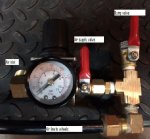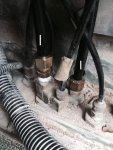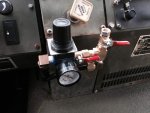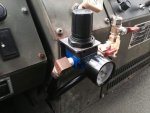tjhuffy
New member
- 20
- 7
- 3
- Location
- Hendersonville, TN
After severals request to start a post on this topic, I'm going to give it a try. I purchased my M-1078 in December with the control box missing from the cab. After reading several posts on the CTIS, and learning there is a lot of people having trouble with them, I decided to go the manual route. For less than $100 I bought a regulator, valves, and fittings to eliminate the electrical part of the system. To install, just run the supply line to the inlet of the regulator, and the air line going to the tires to the bottom of the tee fitting.
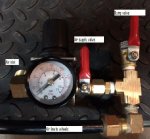
I will try to be brief on how it works.
To inflat the tires;
1. Close both valves
2. Adjust regulator to desired psi
3. Open the supply air valve
4. Once tire pressure is reached close supply air valve
5. Open dump valve quickly, this will allow the tire valves to seat and hold the air at the tires, and the air will exaust from the axles.
To air down the tires;
1. Close both valves
2. Adjust regulator to a psi higher that current tire pressure
3. Open supply air valve just long enough for air to start filling the tires, then close it.
4. Open the dump valve just enough to allow some air to exaust, when this happens, the quick-release valves on the frame will start to dump the air from the tires, close it and allow the tires to deflate to the desired psi. Note: not all of the tires will deflate at the same rate, on my truck there is a range of about 5 psi difference in them, you will lower them below the desired psi.
5. To equilize the pressure of the tires, repeat the steps above on inflating the tires to there new lower psi.
tjhuffy

I will try to be brief on how it works.
To inflat the tires;
1. Close both valves
2. Adjust regulator to desired psi
3. Open the supply air valve
4. Once tire pressure is reached close supply air valve
5. Open dump valve quickly, this will allow the tire valves to seat and hold the air at the tires, and the air will exaust from the axles.
To air down the tires;
1. Close both valves
2. Adjust regulator to a psi higher that current tire pressure
3. Open supply air valve just long enough for air to start filling the tires, then close it.
4. Open the dump valve just enough to allow some air to exaust, when this happens, the quick-release valves on the frame will start to dump the air from the tires, close it and allow the tires to deflate to the desired psi. Note: not all of the tires will deflate at the same rate, on my truck there is a range of about 5 psi difference in them, you will lower them below the desired psi.
5. To equilize the pressure of the tires, repeat the steps above on inflating the tires to there new lower psi.
tjhuffy
Attachments
-
12.9 KB Views: 161






